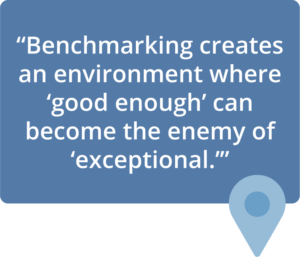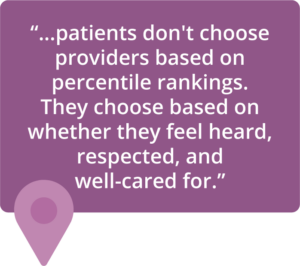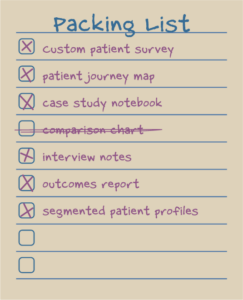“How do we stack up against other organizations?”
It’s probably one of the most common questions healthcare leaders ask when reviewing their patient experience metrics. And it’s a perfectly natural question. After all, we’ve been conditioned to believe that competitive benchmarking is essential to improvement. If we’re “beating” the competition, we must be doing something right. If we’re falling behind, we clearly have work to do.
But what if we told you that the industry’s obsession with benchmarking might actually be holding you back from delivering truly exceptional patient experiences?
Across the healthcare industry, a pattern has emerged: when organizations become overly focused on benchmark superiority, they often lose sight of what truly matters: creating meaningful, personalized experiences that address the unique needs of their specific patient populations. This industry-wide fixation on comparative metrics deserves closer examination.
The Allure of Benchmarking
Let’s be honest—benchmarking is appealing. It’s concrete, it’s quantifiable, and it gives you a sense of where you stand. When the quarterly CAHPS results arrive, the first thing most executives do is flip to the percentile rankings.
“We’re in the 82nd percentile for nurse communication!”
“Our wait time satisfaction scores are below the 50th percentile.”
These comparisons feel important. They seem to tell a story about quality. And there’s certainly some value in understanding the broader landscape.
But here’s the problem: benchmarking creates an environment where “good enough” can become the enemy of “exceptional.”
The Benchmarking Pitfalls
When healthcare organizations become too fixated on benchmarks, several issues emerge:
The Relativity Problem
Benchmarking only tells you how you’re doing compared to others, not how you’re doing compared to your patients’ actual expectations. If everyone in your specialty is providing mediocre service in a particular area, being “above average” isn’t much of an achievement.
Consider this: many healthcare organizations celebrate when they reach the 90th percentile in certain metrics. But think about what that means from the patient’s perspective. If you’re in the 90th percentile for appointment wait times, you’re still leaving 10% of comparable organizations with better wait times than yours. And for the patients who have to wait longer than they’d like, knowing you’re “better than most” provides little comfort.
The Averaging Effect
Benchmarks typically represent averages across diverse organizations, patient populations, and contexts. But healthcare isn’t experienced in averages—it’s experienced individually, one patient at a time.
Your urban specialty clinic serving primarily working professionals has fundamentally different patient experience challenges than a rural general clinic serving an aging population. Yet benchmarking tools often lump these distinct environments together.
The Lagging Indicator Issue
Most benchmark data is inherently backward-looking. By the time you receive and analyze the data, it’s already describing a reality that existed weeks or months ago. Patient expectations, meanwhile, continue to evolve rapidly, influenced by experiences far beyond healthcare.
Today’s patients don’t just compare your check-in process to other medical offices—they compare it to the seamlessness of ordering an Uber or checking in for a flight. Benchmark data rarely captures these cross-industry expectations.
The False Security Problem
Perhaps most dangerously, “good” benchmark results can create a false sense of security. It’s easy for healthcare organizations to become complacent after reaching the 75th percentile in key metrics, only to be blindsided when patient volumes begin to decline despite their “above average” performance.
 Moving Beyond Comparison
Moving Beyond Comparison
To be clear, we’re not suggesting you abandon benchmarking entirely. Rather, we’re advocating for a more nuanced approach—one that uses benchmarks as just one tool in a much larger patient experience toolkit.
Here’s what that might look like:
Start With Patient-Defined Value
Instead of beginning with “How do we compare?” start with “What matters most to our specific patients?”
This requires deep, qualitative research. It means customizing surveys and building journey maps that identify the moments that disproportionately shape patient perceptions. It also means recognizing that what matters to patients often varies significantly across different segments of your patient population.
Measure What Matters, Not Just What’s Measured
Standard benchmarking tools measure what’s easy to compare, not necessarily what’s most important to your patients.
Consider developing custom surveys using tools like SocialClimb to access metrics that align with your unique patient priorities and organizational mission. If your organization serves primarily elderly patients with chronic conditions, perhaps continuity of care coordination deserves its own dedicated measurement, even if it’s not part of standard benchmark surveys.
Focus on Trends, Not Just Standings
Your own improvement trajectory often tells a more meaningful story than your position relative to others. A hospital that’s moved from the 40th to the 60th percentile in six months is likely doing more things right than one that’s hovered at the 70th percentile for years.
Track your own trends over time, especially after implementing specific experience initiatives. This internal benchmarking often yields more actionable insights than external comparisons.
Learn From Outliers, Not Averages
 Instead of aiming to be better than average, identify and learn from the absolute best performers, both within and outside healthcare.
Instead of aiming to be better than average, identify and learn from the absolute best performers, both within and outside healthcare.
What can you learn from the primary care practice that’s somehow managed to maintain 95% on-time appointments? Or from the specialty clinic that’s achieved unprecedented patient portal adoption rates? These outliers, rather than industry averages, should inform your goals.
Connect Experience to Outcomes
Perhaps most importantly, move beyond measuring satisfaction in isolation. The most sophisticated healthcare organizations are now connecting experience metrics to clinical outcomes, determining which aspects of the patient experience most directly impact health results.
The Path Forward
Healthcare leaders who truly want to differentiate their organizations need to recognize that excellence in patient experience isn’t achieved through comparison—it’s achieved through deeper understanding.
Understand who your specific patients are and what they uniquely value. Consider how their expectations are shaped by experiences both within and beyond healthcare. Understand which moments in their journey disproportionately impact their perceptions and decisions.
None of this understanding comes from benchmarks alone.
Instead of asking “How do we compare?” perhaps the better question is “How well do we understand our patients’ needs, and how effectively are we meeting them?”
 Because ultimately, patients don’t choose providers based on percentile rankings; they choose based on whether they feel heard, respected, and well-cared for. Whether their individual needs are understood and addressed. They make decisions based on their own personal experiences—not on how those experiences compare to statistical averages.
Because ultimately, patients don’t choose providers based on percentile rankings; they choose based on whether they feel heard, respected, and well-cared for. Whether their individual needs are understood and addressed. They make decisions based on their own personal experiences—not on how those experiences compare to statistical averages.
So by all means, glance at the benchmarks. But don’t let them distract you from the deeper work of truly understanding and addressing what matters most to your patients. That’s where true differentiation—and excellence—lies.
In a healthcare landscape where many organizations are chasing the same benchmarks in the same ways, those who focus less on comparison and more on deep understanding will be the ones who truly stand out.
In a time where patients have more choices than ever before, standing out isn’t just nice to have—it’s necessary for success.
Moving Forward: Questions to Consider
 As you reflect on your own approach to patient experience measurement and improvement, consider:
As you reflect on your own approach to patient experience measurement and improvement, consider:
- What would change in your strategy if you focused less on benchmarks and more on patient-defined value?
- Which aspects of your patient experience aren’t captured in standard benchmarking tools?
- How might you better connect patient experience metrics to meaningful clinical and business outcomes?
- What can you learn more from outlier performers rather than from industry averages?
The answers might just lead you to a patient experience strategy that truly differentiates your organization—not just in percentile rankings, but in the hearts and minds of your patients.











